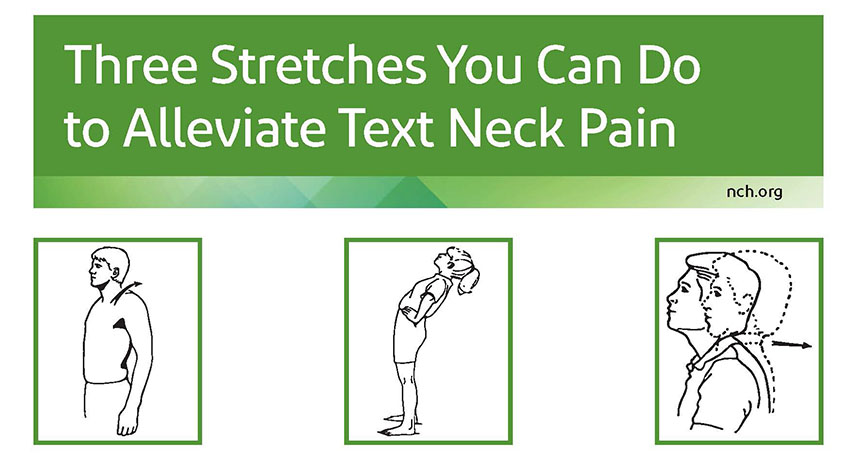Experiencing neck pain? You could have ‘text neck’
August 17, 2017
Here are several ways to combat it

If you’re bent over your cell phone or handheld device a good portion of the day, you may have “text neck,” or forward head posture.
According to the Spine-Health website, it’s “the term used to describe the neck pain and damage sustained from looking down at your cell phone, tablet or other wireless devices too frequently and for too long.” Headaches, neck pain, shoulder pain, pinched nerves and spinal degeneration are among the ailments people experience.
Anita Stehmeier, P.T., an Ergonomic Program Therapist with Northwest Community Healthcare (NCH), says, “At least 80 percent of the people I see have a forward head posture ranging from slight to severe.”
Children and teens are at risk because they tend to spend long periods of time texting friends and/or playing computer games while their spines are still developing.
“Holding your head at a 45-degree angle for an extended period of time creates stress on the spine, muscles, tendons and nerves, resulting in pain and pressure,” says Elizabeth Ziemann, M.D., Medical Director of Medical Informatics and a Family Medicine Physician with NCH Medical Group. “Parents need to limit the time their children spend on devices, and the general population can reduce the effects of text neck by holding devices straight in front of them.”
Positioning
Ergonomic positioning can help prevent text neck-associated pain. Stehmeier recommends:
- Supported postures
- Putting a pillow or purse under your arms when holding a phone or tablet
- Ergonomic positioning of your laptop or desktop
Massaging/stretching
Massaging with tennis balls can help with pain and sore muscles. Place a tennis ball in a pillowcase, toss it over your shoulder and, with your back to the wall, rock side to side.
Preventive measures include the following postural reset stretches:
- Neck retraction – Pull head straight back, keeping jaw and eyes level
- Upper back and neck – Stand upright, bend your elbows, point your little fingers backward, pull your shoulder blades down and in, hold for five seconds and then relax
- Shoulder circles – Shrug shoulders up, back, down, forward and repeat
Stehmeier also recommends seeing a physical therapist or personal trainer for scapular strengthening.
In addition, the Text Neck Institute recommends altering the angle of the head while texting. Holding a cell phone at an angle of 70 to 90 degrees from the floor can ease text neck symptoms. There are also mobile apps available, like the Text Neck Indicator LITE, which signals when a phone is being held at an acceptable angle.
